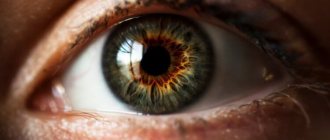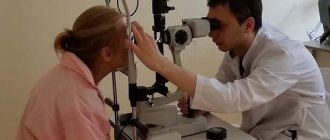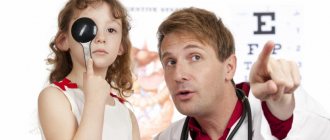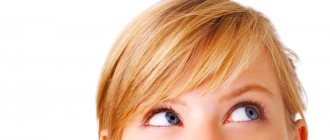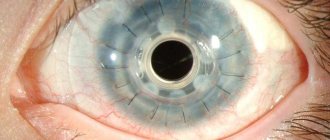A person looks at the world with two eyes, but sees only one picture. This happens due to the fact that the brain combines two images that are projected onto the central parts of the retinas into one visual image. As a result of the merging of two pictures, a three-dimensional image is created in the human mind, which forms the binocular vision system.
Thanks to this, you can feel volume, relief with your eyes and determine the exact location of objects in space. This is how the visual system of a healthy person works, but how cross-eyed people see can hardly be determined only by the movement of their eyes, which usually look in different directions. To do this, you need to take into account a number of factors that trigger the formation mechanism of this pathology.
Mechanism of development of strabismus
Each organ of vision has six muscles. They are the ones who ensure synchronous movement of the eyeballs. That is, when changing the direction of gaze, both eyes must make not only a simultaneous, but also a unidirectional movement, which will ultimately fix the gaze on one point of the object in question. And when the coordinated work of the visual muscles is disrupted, the eyes begin to move and look in different directions. This pathology is called strabismus, but in medicine it is better known under the term strabismus or heterotropia.
Strabismus is one of the few ophthalmological diseases that can be diagnosed even without the help of a doctor. That is why many people perceive this pathology only as an aesthetic defect, without thinking that it also entails a functional visual impairment. The reasons that cause a malfunction in the synchronous functioning of the visual muscles can be very different, but they determine the type and nature of strabismus.
Features of vision of cross-eyed people
A person with normal vision may wonder how cross-eyed people see. Let's try to figure out whether this physical defect affects the acuity of human vision, or whether strabismus can be considered just a cosmetic defect.
How do people with strabismus perceive the world around them?
When you meet a person with such a feature of the eye structure, strabismus can be determined after a few seconds of communication. In relation to their defect, cross-eyed people are divided into two categories:
- People who treat this shortcoming evenly and calmly.
- People who are embarrassed by their squint, seeing that their interlocutors are carefully peering into their faces.
Strabismus is a physical ailment of a person. By the way you treat people with strabismus, you can understand how well raised you are and how developed your sense of compassion for your neighbor is. After all, a negative attitude towards human vices never elevates anyone.
Strabismus is a deviation from the norm in the structure of human eyes, in which a person cannot focus his gaze in one direction, which corresponds to normal development. With strabismus, the eyes look in different directions.
In a healthy person, the image of objects falls on the middle sections of the retinas of both eyes. The impulse is transmitted to the brain, in which the images received by both retinas are merged into one. This is how binocular vision is formed, in which a single three-dimensional image is created, which is perceived by a person as voluminous and relief.
And with strabismus, the images do not merge in the brain, because they are not projected into the symmetrical parts of the retinas of both eyes. A person with such a defect experiences double vision of all surrounding objects. It is difficult for the brain to cope with the projection of two different images, so the squinting eye involuntarily switches off from the process responsible for the formation of vision. With long-term observation of this patient's condition, the development of amblyopia, which is popularly called lazy eye, may occur.
How do cross-eyed people see if their vision is not binocular? Such people have monocular vision. They do not have the ability to see three-dimensional images, to see objects in volume and relief.
There is a problem of latent strabismus occurring in people, which prevents the merging of perceived objects from both retinas. In the latent form, a person has binocular vision. This pathology is most often characteristic of young children. With a competent approach from a specialist, she can be treated. As children get older, their eyes stop squinting.
How an image is formed in the mind of a cross-eyed person
All cross-eyed people lack stereoscopic vision, which means they cannot perceive surrounding objects in three dimensions. This happens due to the fact that when looking at an object, the image reflected from it is projected onto different parts of the retinas. Accordingly, the visual analyzer of the central part of the nervous system cannot merge these two pictures into one, and as a result, two images are formed in a person’s consciousness. The brain begins to protest against such optical discomfort and turns on a defense mechanism that completely ignores the image of the defective eye. It is important to take into account that with a long course of the disease, a person begins to develop functional vision loss or amblyopia, in which one eye sees practically nothing. They call him lazy because he completely switches off from the visual process. Therefore, all cross-eyed people with amblyopia look at the world with monocular vision and are not able to perceive it comprehensively and fully.
What picture do people with strabismus see?
People who have strabismus suffer from a lack of stereoscopic vision. Therefore, they do not have the ability to perceive surrounding objects in three dimensions. This is due to the fact that when you try to look at a certain object, reflection from it occurs in different parts of the retina. The vision analyzer in the central nervous system does not have the ability to combine two pictures into one. Therefore, a person sees two images.
The brain denies the presence of such visual discomfort. A protective function is activated, which ignores the resulting image from the sideways eye. If the disease is long-term, the risk of developing amblyopia and decreased vision increases. It is important to consider that with amblyopia, one eye is completely blind.
Doctors call it the lazy eye because it stops participating in the visual process. This process is irreversible. People with strabismus and amblyopia have monocular vision. Therefore, they cannot perceive the world fully and in its entirety. From early childhood, it is important to monitor the condition and development of the visual apparatus. The function of vision depends on this.
The nature of vision is studied using special methods. For example, peripheral vision is determined using perimetry. In order to control this indicator, a person should visit an ophthalmologist 1-2 times a year. Violations may be accompanied by the development of pathological processes. The examination will require special diagnostics using the perimeter. This device is intended for diagnosing ophthalmological diseases and brain conditions. After this, the doctor has the opportunity to prescribe drug therapy.
Why do the eyes start looking in different directions?
Unfortunately, strabismus affects both children and adults equally. Moreover, the reasons for its development can be both congenital and acquired, and the most common of them include:
- anomalies of intrauterine development of the fetus;
- moderate and high degree optical impairment of visual acuity;
- neurological problems;
- complications after infectious diseases;
- abnormalities of the extraocular muscles;
- stress and mental disorders;
- serious head injuries;
- inadequate load on the visual system:
- rapid deterioration of visual acuity in one eye.
If the eye begins to squint even a little, then this is the main sign of the development of strabismus. In a child, parents should be the first to notice such a deviation. They are the ones who are obliged to immediately seek advice from an ophthalmologist, who at an early stage will help stop the development of the disease and correct the existing visual and functional defect.
In adults, strabismus can have a different nature of origin. If the illness lasts from childhood, this means that the person is accustomed to seeing the world as flat, and, apart from a cosmetic defect, this illness no longer bothers him. If the cause of the deviation is external factors, then the main sign of such strabismus is no longer just an aesthetic defect. The thing is that in adults the adaptive properties of the brain are reduced and therefore it cannot turn off the image of the diseased eye. As a result, such patients begin to suffer from double vision, dizziness and constant headaches. In search of a convenient viewing angle, a person begins to squint one eye and constantly tilt his head to one side.
What is strabismus?
In order to understand how cross-eyed people see, it is necessary to determine not only the causes of the development of the disease, but also to classify the disease according to all the characteristics that form it, which can be divided:
- by type: hidden, imaginary and true;
- by form: friendly, paralytic and atypical;
- by type: convergent, divergent, vertical and mixed;
- according to eye involvement: unilateral and intermittent;
The complex structural and functional structure of the visual system determines the presence of a large number of all kinds and forms of strabismus. The success of conservative and especially surgical treatment of such a deviation largely depends on their correct classification.
Forms of origin of strabismus
The form of strabismus is concomitant and paralytic. Poor heredity, abnormalities in the structure of the organ of vision and childhood are often the main reasons for the development of concomitant strabismus. In this case, the eyes squint alternately, and the angle of deviation from the central axis of the retina is approximately the same in each eye. That is, the movement of the eyeballs with this form of deviation is preserved in full. If a person focuses on an object with a squinting eye, then the normal organ of vision will turn the same distance. In other words, parity of the primary and secondary deflection angle is formed. Children with this form of strabismus never experience double vision, since they immediately develop amblyopia.
Incorrect pupil position
What is strabismus and how does it manifest?
People with slanted eyes are relatively rare and always attract attention. Upon closer inspection, you will notice that they all mow differently. Ophthalmologists classify this deviation from the norm as follows, which is presented in the table:
| Violation | Peculiarities |
| Convergent strabismus | The pupils move towards the bridge of the nose (esotropia) |
| Divergent | Each eye looks at its own temple (exotropia) |
| Vertical | Direction of gaze up or down (hypertrophy and hypotrophy) |
| Mixed | Combination of 2 types in different options |
A child born with strabismus must receive the necessary ophthalmological care before the age of 4 to correct the pathology.
All these types can be one-sided, when the squinting eye is always the same, or alternating, alternating, in which the pupils are slanted in turn. With the congenial form, the eyeballs move normally, while the paralytic form limits movement completely or partially. To officially make a diagnosis, you need to test your vision for binocularity. The procedure is carried out in a clinic on the direction of a doctor.
How do people with strabismus see the world?
Pathology is not only a cosmetic defect. For some people, a developmental disability does not pose a problem, while for others it creates an inferiority complex and requires the help of a psychotherapist. From a medical point of view, options for visual perception are possible. Patients with slanted pupils see the world somewhat differently than healthy people. They experience visual discomfort, which manifests itself as follows:
The “tired eyes” syndrome with strabismus is more pronounced.
- doubling of objects (not in all cases);
- rapid eye fatigue when reading and working with a PC;
- headache;
- vertigo (dizziness);
- weakened vision;
- squinting;
- forced uncomfortable position of the head - rotated or inclined;
- lack of stereo perception, that is, the world seems flat (not in all forms).
Diagnosis of strabismus
Correct diagnosis is the basis for successful treatment, and strabismus is no exception. The thing is that with the same external symptoms, this pathology is replete with a variety of all kinds. Therefore, before starting treatment, the doctor, based on the patient’s complaints, must determine the cause of strabismus and be sure to conduct a full ophthalmological examination of the visual system. It is carried out on high-precision diagnostic equipment, using special computer programs, tables, mirrors and usually consists of the following procedures:
- general vision examination;
- complete refraction of the visual system;
- measuring the strabismus angle using different methods;
- checking the synchronous operation of both eyes;
- conducting a stereoscopic vision test;
- study of pupil mobility in all directions.
If strabismus has developed as a result of neurological abnormalities, the patient is given a consultation with a neurologist, a computed tomography scan is performed, and an x-ray is taken.
The principle of treatment of strabismus
Strabismus is a disease that changes the visual perception of the world, worsens the quality of life, limits performance and often causes psychological discomfort. Unfortunately, this disease never goes away on its own, and therefore it must be treated. The scheme for correcting strabismus is selected by the ophthalmologist based on the examination and taking into account the patient’s age, the reasons for the development of the pathology and the presence of a lazy eye. But regardless of the type of strabismus, the principle of its treatment is based on solving three important problems:
- restoration of vision of a lazy eye;
- correcting an aesthetic defect by establishing the symmetry of the two pupils;
- stimulation of the development of three-dimensional vision.
Strabismus prevention
It is important to know that most often children aged 2 to 3 years are susceptible to strabismus, when their pupils are just beginning to develop their pupils. Therefore, children are the first to be at risk for this disease. This means that only early diagnosis is today the most effective measure to prevent the development of strabismus.
In order not to miss the onset of the formation of the disease, it is necessary to conduct a preventive examination with a pediatric ophthalmologist every six months. Particular attention should be paid to patients with congenital anomalies, poor heredity and children who have suffered birth injuries. Only timely treatment of ophthalmological diseases, compliance with the rules of visual stress and regular visits to the doctor will help avoid the development of strabismus and amblyopia.
Existing types of strabismus
From the point of view of the type of deviation, strabismus is classified:
- Converging form - with it the patient’s eyes gather in a group, the direction of gaze is directed towards the bridge of the nose. This form is often found in farsighted people.
- Divergent form - the gaze of a sick person diverges to the sides, it is directed towards the temples. This form is often found in nearsighted people.
- Vertical shape - the patient's eyeball is directed up or down.
- Mixed form - possible with a combination of several forms of strabismus.
Taking into account the origin of strabismus, it is divided:
- Friendly form - with this form, the movements of the eyeballs are not impaired. Most often, this form affects children under 5 years of age.
- Paralytic form - with this form, the movements of the eyeball of the squinting eye are limited. A person suffering from this form of the disease has a feeling of double image.
Considering the involvement of the eyes in the disease, strabismus can be:
- One-sided form - with this form, a person has one eye squinting.
- Intermittent form - deviation from the visual axis is observed either in the right or in the left eye.

